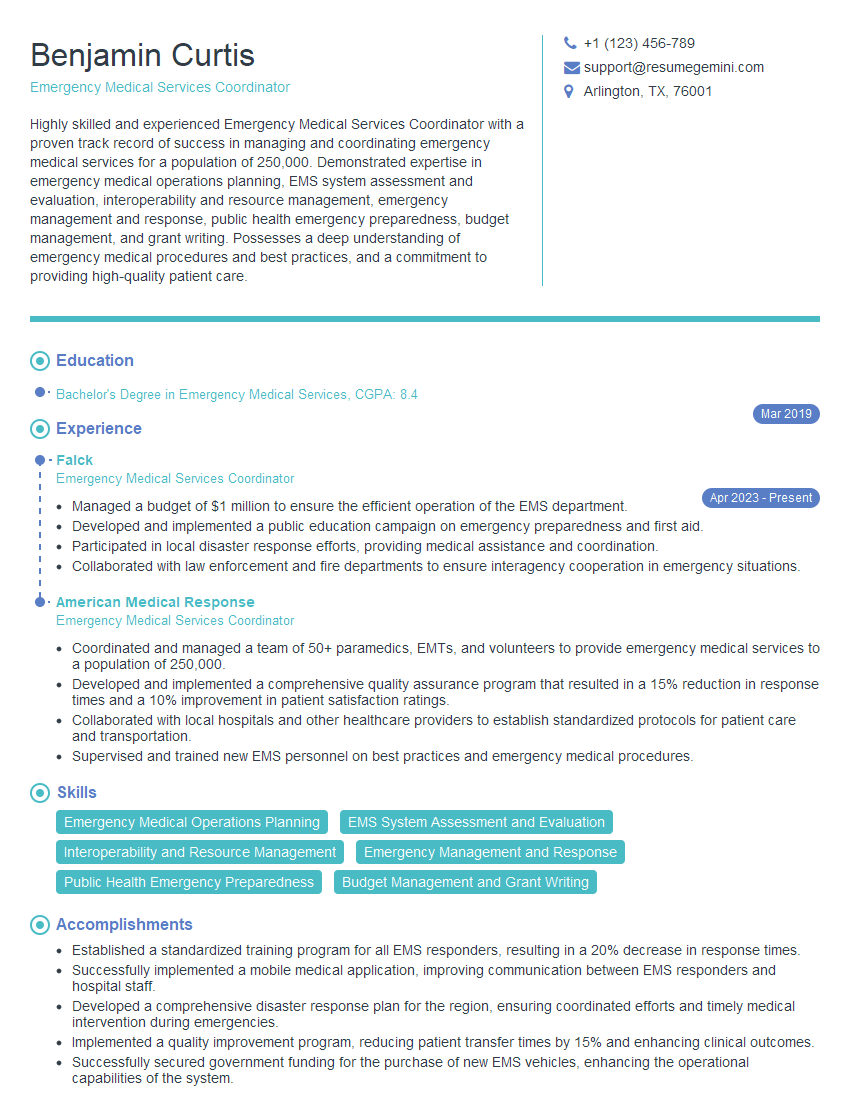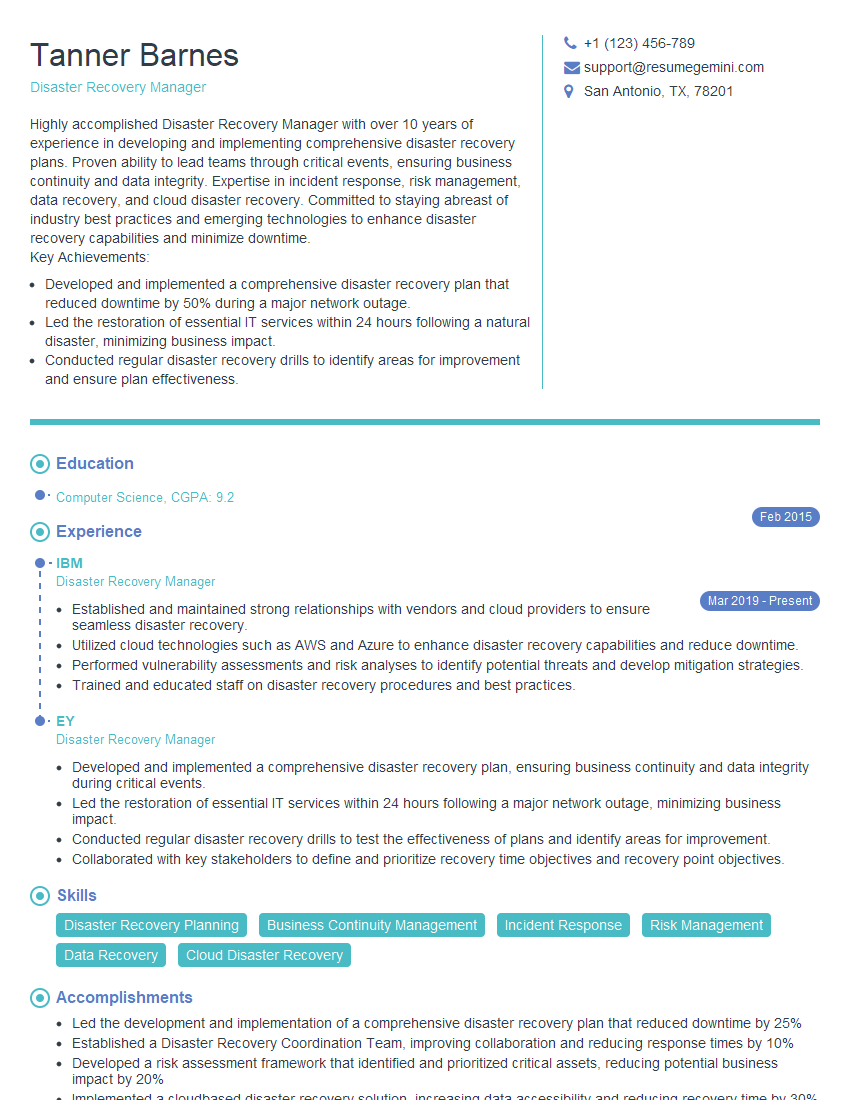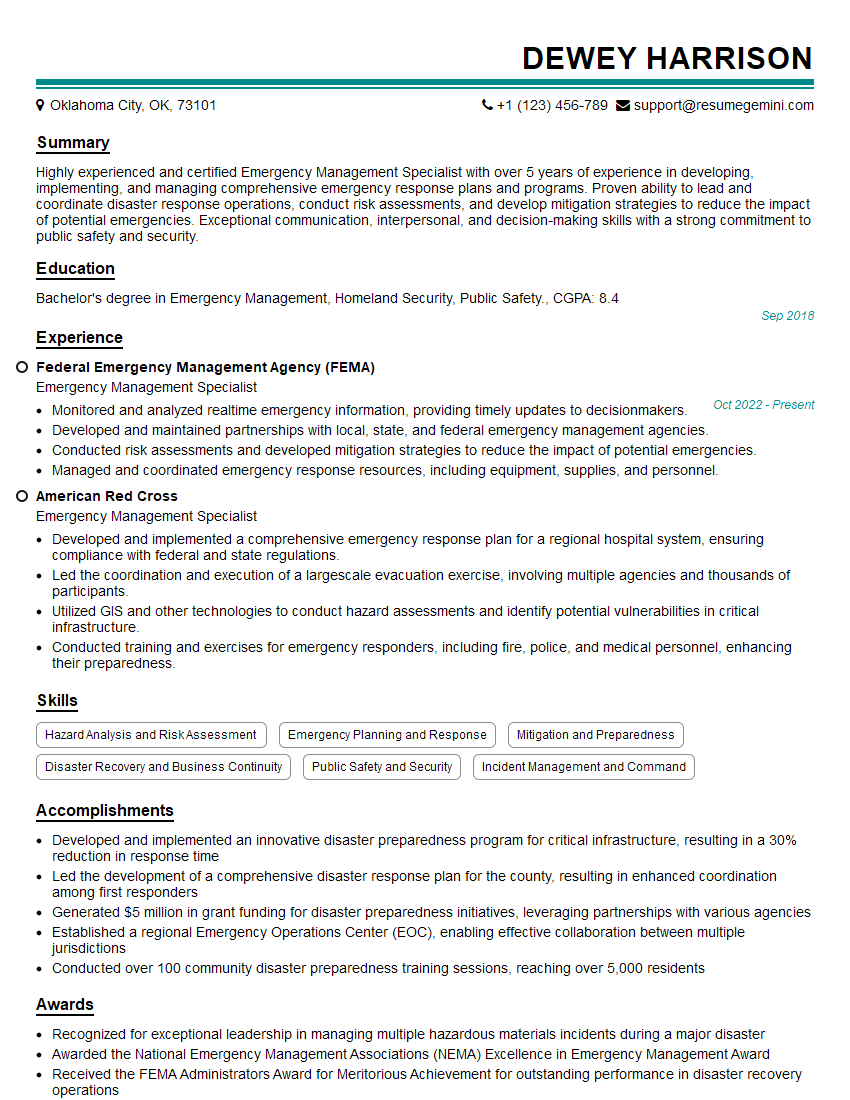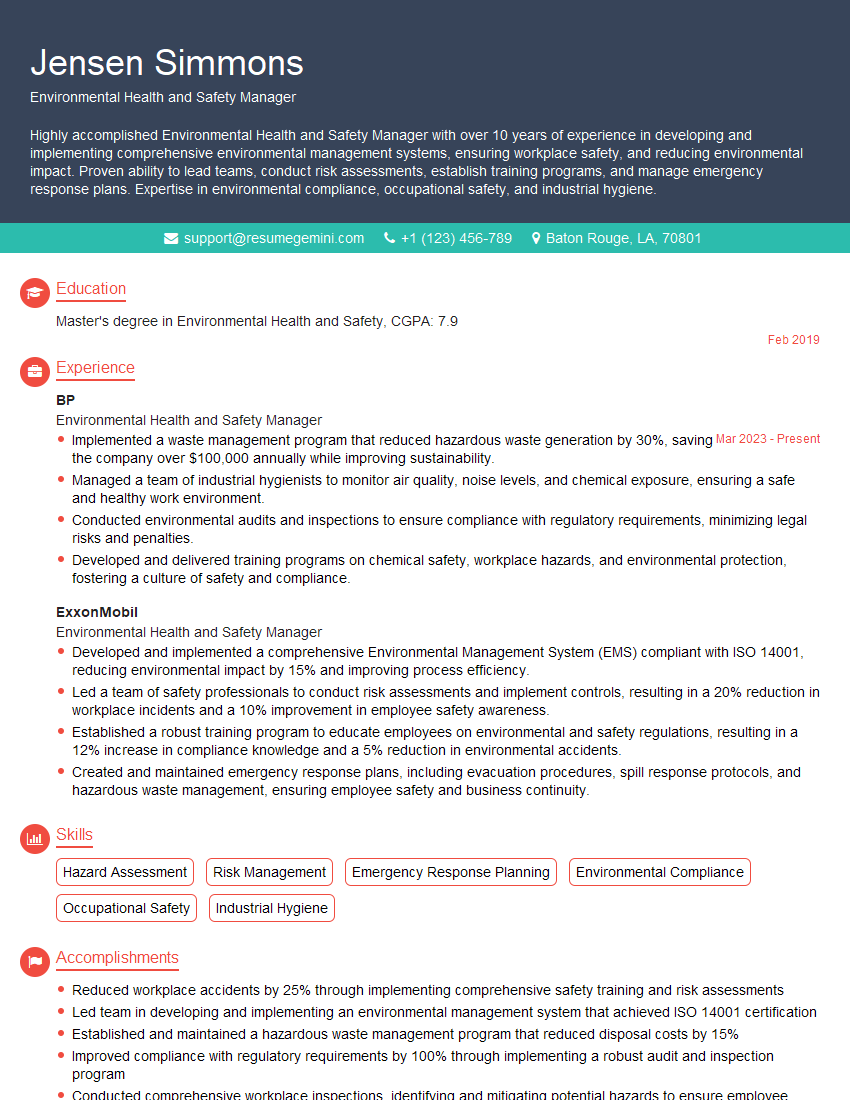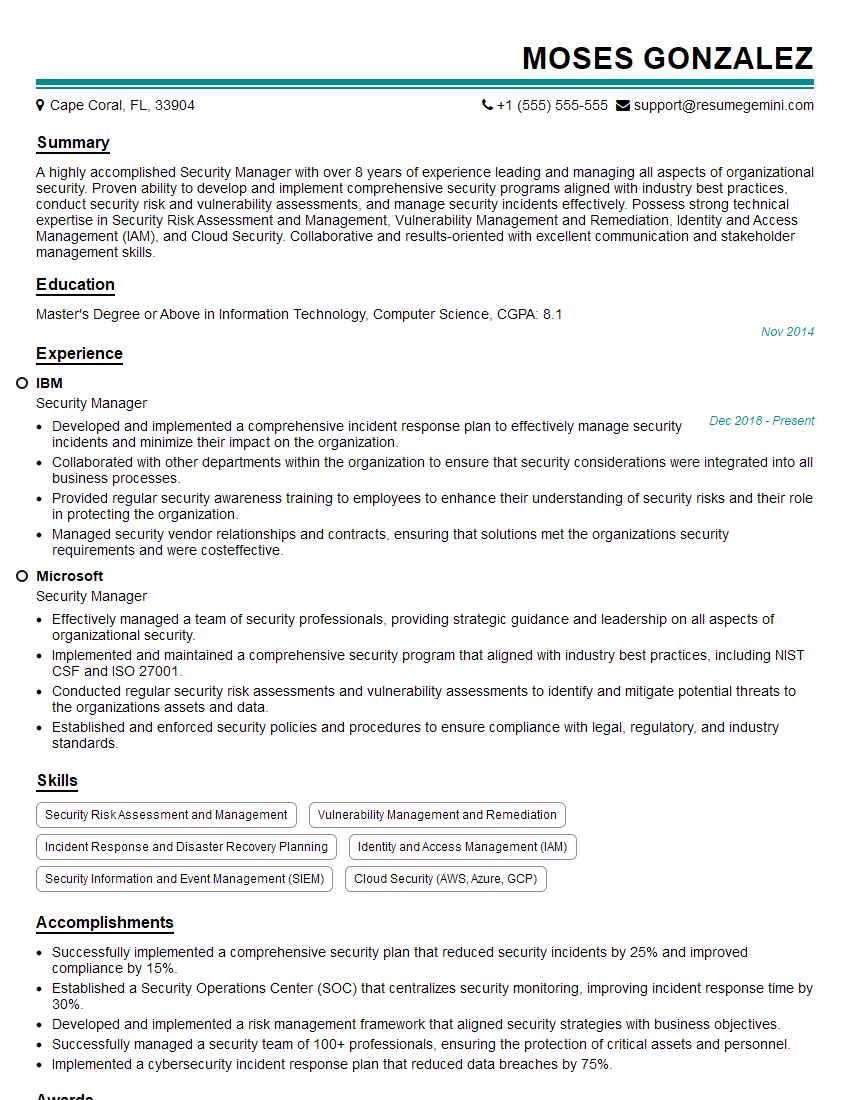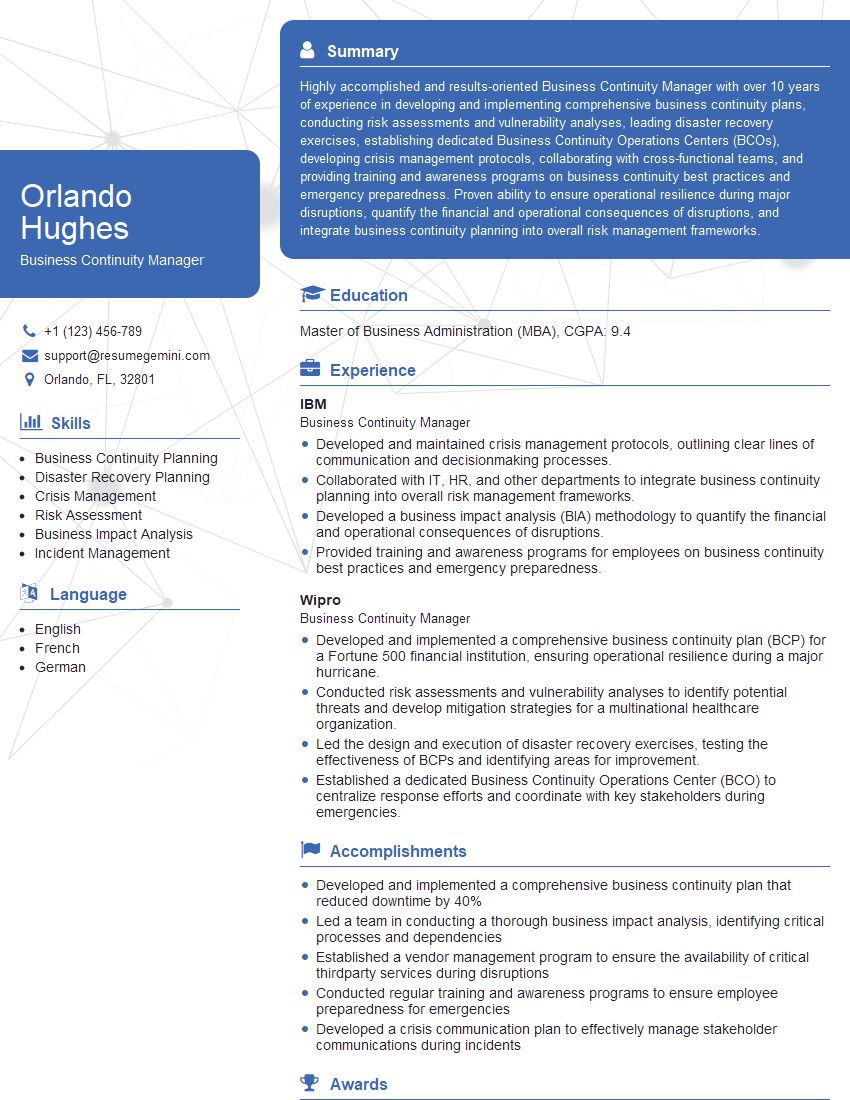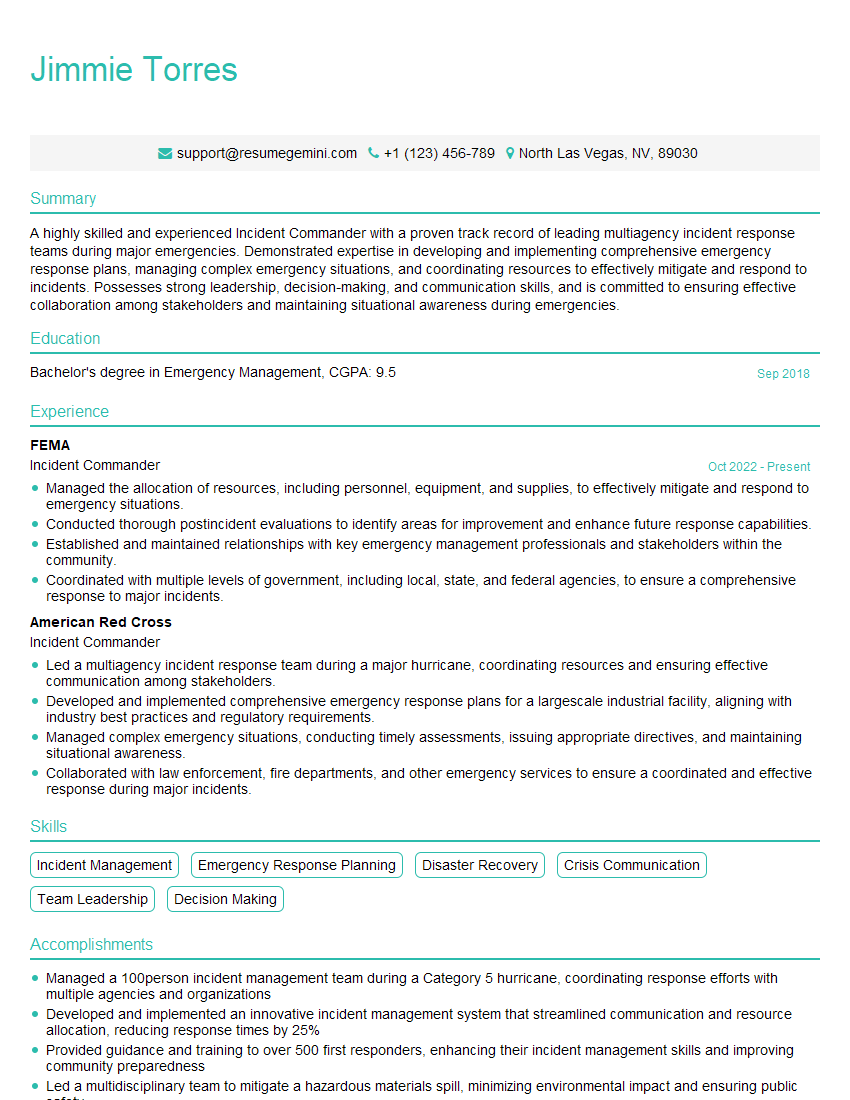Interviews are opportunities to demonstrate your expertise, and this guide is here to help you shine. Explore the essential Expertise in Emergency Response and Incident Management interview questions that employers frequently ask, paired with strategies for crafting responses that set you apart from the competition.
Questions Asked in Expertise in Emergency Response and Incident Management Interview
Q 1. Describe your experience with incident command systems (ICS).
Incident Command Systems (ICS) are standardized, on-scene, all-hazards incident management system. Think of it as a blueprint for organizing and coordinating emergency response. My experience spans over a decade, involving numerous large-scale incidents, from wildfires and floods to hazardous material spills and mass casualty events. I’ve worked in various ICS roles, from Unit Leader to Operations Section Chief, gaining hands-on experience in all phases of the incident management cycle – preparation, response, recovery, and mitigation.
- Preparation: This involves pre-planning, training exercises, and resource identification, ensuring we’re ready for anything.
- Response: During an incident, ICS provides a framework for establishing clear roles and responsibilities, efficient communication, and effective resource allocation. I’ve used ICS to effectively coordinate teams of firefighters, paramedics, law enforcement, and other support personnel.
- Recovery: ICS helps transition from immediate response to long-term recovery efforts, ensuring continuity of operations and minimizing further damage.
- Mitigation: Post-incident analysis allows for lessons learned and implementing corrective actions to reduce future risk.
For example, during a large-scale wildfire, I led the Operations Section, coordinating firefighting resources, establishing control lines, and managing the evacuation of affected communities. The ICS structure was crucial in maintaining order and efficiency in a chaotic environment.
Q 2. Explain the process of developing an emergency response plan.
Developing an emergency response plan is a crucial proactive measure. It’s a systematic process involving hazard identification, vulnerability assessment, capacity analysis, and resource allocation. The process typically involves these steps:
- Hazard Analysis: Identifying potential threats, such as natural disasters (earthquakes, floods), technological accidents (chemical spills), or human-caused incidents (terrorist attacks).
- Vulnerability Assessment: Determining the potential impact of identified hazards on the community, infrastructure, and environment. This might involve mapping critical infrastructure and identifying vulnerable populations.
- Capacity Analysis: Assessing existing resources and capabilities to handle emergencies. This involves inventorying personnel, equipment, and communication systems.
- Plan Development: Creating a detailed plan outlining procedures for different emergency scenarios. This includes communication protocols, evacuation plans, resource allocation strategies, and post-incident recovery procedures.
- Training and Exercises: Conducting regular training exercises to ensure that personnel are familiar with the plan and can effectively respond during an emergency. Tabletop exercises, drills, and full-scale simulations are valuable tools.
- Plan Review and Updates: Regularly reviewing and updating the plan based on lessons learned from incidents, changes in the environment, or new technologies.
A well-developed emergency response plan is not a static document. It needs to be a dynamic, living document, constantly adapting to changing circumstances and incorporating lessons learned.
Q 3. How do you prioritize tasks during a crisis?
Prioritizing tasks during a crisis is paramount. I utilize a structured approach based on the principle of saving lives first, then stabilizing the situation and preventing further harm. I use the START triage system (Simple Triage And Rapid Treatment) which is a rapid assessment method for prioritizing treatment during mass-casualty incidents. It’s a visual method employing colored tags: red (immediate), yellow (delayed), green (minor), and black (deceased/expectant).
Beyond immediate life-saving, priorities are determined through a combination of:
- Impact Assessment: Identifying tasks with the greatest potential impact on loss of life, property damage, or environmental consequences.
- Time Sensitivity: Focusing on tasks with the shortest critical time window for action.
- Resource Availability: Matching tasks to available personnel, equipment, and other resources.
- Dependency Analysis: Identifying tasks that are prerequisites for other, higher-priority actions.
For instance, during a building collapse, rescuing trapped individuals would be the top priority (red tag – immediate action needed), followed by stabilizing the structure to prevent further collapse, securing the perimeter, and then addressing injuries to those already rescued (yellow tag – delayed care).
Q 4. What are your methods for effective communication during an emergency?
Effective communication is the backbone of any successful emergency response. My methods emphasize clarity, conciseness, and redundancy. I use a multi-channel approach:
- Common Operating Picture (COP): Utilizing maps, diagrams, and real-time data to provide a shared understanding of the situation among all responders.
- Radio Communication: Using clear, concise radio transmissions, following established protocols to avoid confusion. Utilizing tactical channels and a clear chain of command for efficient communication flow.
- Written Reports and Documentation: Maintaining detailed records of actions taken, resource allocation, and communication exchanges. This assists in post-incident analysis and accountability.
- Briefings and Debriefings: Conducting regular briefings to keep personnel informed and debriefings to review successes and areas for improvement.
- Public Information Officer (PIO): Working closely with the PIO to ensure consistent and accurate information is communicated to the public.
Imagine a chemical spill – clear, concise radio communication is critical to coordinate the evacuation of residents, direct hazmat teams, and relay information to the public through the PIO. Redundancy is key. Multiple communication channels are necessary in case one fails.
Q 5. How do you assess and mitigate risks in emergency situations?
Risk assessment and mitigation are continuous processes throughout the emergency response cycle. I utilize a structured approach:
- Hazard Identification: Identifying potential threats, including their likelihood and severity.
- Vulnerability Assessment: Determining the susceptibility of assets and populations to the identified hazards.
- Risk Analysis: Combining hazard likelihood and vulnerability to determine the overall risk level.
- Risk Mitigation: Developing strategies to reduce risk, such as implementing preventive measures, developing contingency plans, and establishing early warning systems.
- Monitoring and Review: Continuously monitoring the situation and reviewing risk mitigation strategies as conditions change.
For instance, during a hurricane, the risk assessment might include evaluating the likelihood of flooding, wind damage, and power outages. Mitigation strategies might include evacuation orders, strengthening critical infrastructure, and stockpiling emergency supplies.
Q 6. Describe your experience with resource allocation during an emergency.
Resource allocation during an emergency requires careful planning and efficient execution. It’s about getting the right resources to the right place at the right time. My experience involves managing diverse resources, including personnel, equipment, supplies, and funding.
My approach incorporates:
- Needs Assessment: Identifying the specific resources required to address the immediate and long-term needs of the incident.
- Resource Inventory: Maintaining an up-to-date inventory of available resources, including their location and capabilities.
- Prioritization: Prioritizing resource allocation based on the criticality of tasks and the availability of resources.
- Resource Tracking: Tracking the deployment and utilization of resources to ensure efficiency and accountability.
- Resource Request and Coordination: Efficiently requesting additional resources from external agencies when needed.
During a major earthquake, for example, efficient allocation of ambulances, medical personnel, search and rescue teams, and emergency supplies was critical in saving lives and minimizing casualties.
Q 7. How do you handle conflicting priorities in a high-pressure environment?
Conflicting priorities in high-pressure environments are inevitable. I handle them using a structured decision-making process:
- Clearly Define Priorities: Establish clear criteria for prioritizing tasks, based on factors such as impact, urgency, and resource availability.
- Facilitate Collaboration: Involve key stakeholders in the decision-making process to gain diverse perspectives and find common ground.
- Negotiation and Compromise: Employ negotiation skills to find solutions that address competing needs, while acknowledging the constraints of time and resources.
- Documentation and Transparency: Document the decision-making process, including the rationale behind the choices made. This enhances transparency and accountability.
- Adaptive Management: Remain flexible and adapt the plan as new information becomes available or priorities shift.
For example, balancing the need for immediate search and rescue efforts with the need to establish security perimeters and prevent looting might require careful negotiation and prioritization of resources.
Q 8. Explain your experience with post-incident analysis and reporting.
Post-incident analysis is crucial for learning from mistakes and improving future responses. My process involves a structured approach, beginning with immediate fact-finding to secure the scene and ensure personnel safety. This is followed by a detailed investigation, employing various methods like interviews with involved personnel, review of communication records, and analysis of equipment performance. We then identify contributing factors, whether human error, equipment malfunction, or systemic issues. Finally, we develop corrective actions, documenting them in a comprehensive report with recommendations for improved protocols, training, or resource allocation.
For example, during a large-scale chemical spill incident, our post-incident analysis revealed a communication breakdown between the on-site team and the emergency command center. This led us to implement a new communication system with redundant channels and regular status updates, significantly improving response coordination in subsequent incidents.
Q 9. What are your strategies for maintaining team morale during a crisis?
Maintaining team morale during a crisis is paramount to effective response. My strategies focus on clear, consistent communication, ensuring everyone understands their roles and the overall plan. This includes regular briefings, providing timely updates, and fostering open dialogue. I also emphasize mutual support and stress the importance of teamwork. Recognition and appreciation of individual efforts, even small ones, go a long way in boosting morale. Finally, access to resources for stress management and psychological support is critical. Knowing they have support helps responders cope with the pressure and trauma they might experience.
During a wildfire response, for instance, we implemented daily team meetings where individuals could share concerns and celebrate successes. Providing access to counselors also proved invaluable in helping the team manage the stress of long hours and potentially traumatic situations.
Q 10. How do you ensure the safety of personnel during an emergency response?
Personnel safety is my top priority. This starts with thorough risk assessments before deployment, identifying potential hazards and developing mitigation strategies. We utilize appropriate personal protective equipment (PPE) based on the nature of the emergency and provide comprehensive training on its use. Clear communication protocols are essential, with established check-in procedures and emergency escape plans. We also emphasize situational awareness, encouraging team members to be vigilant and report any concerns immediately. Regular safety briefings and debriefings reinforce safe practices and address any emerging risks.
For instance, during a hazardous materials incident, we used specialized suits and respirators to protect personnel from exposure. Regular air quality monitoring and the use of escape routes ensured their safety in the potentially toxic environment.
Q 11. Describe your experience with coordinating with external agencies during an emergency.
Effective coordination with external agencies is fundamental. It begins with establishing clear communication channels before an incident occurs. This involves creating contact lists and pre-planning roles and responsibilities. During an emergency, I focus on clear, concise communication, using established protocols and reporting structures. This includes sharing real-time updates, coordinating resource allocation, and establishing unified command structures when necessary. Regular meetings and debriefings with external partners ensure a collaborative approach and build strong working relationships.
In a flood response, we collaborated with the National Guard, local police, and Red Cross to coordinate evacuations, provide shelter, and distribute aid. Clear communication and pre-established agreements streamlined the process, leading to a more efficient response.
Q 12. How familiar are you with different types of emergency response protocols?
I am highly familiar with a wide range of emergency response protocols, including those for natural disasters (earthquakes, floods, wildfires), technological emergencies (chemical spills, nuclear incidents), and human-caused events (terrorist attacks, mass shootings). My understanding encompasses the Incident Command System (ICS), National Incident Management System (NIMS), and various specialized protocols dictated by the specific type of emergency. This includes understanding the roles and responsibilities within each system, the communication protocols, and the decision-making processes. I also stay current with the latest updates and best practices through continuing education and professional development.
This knowledge allows me to quickly assess a situation and tailor the response accordingly, selecting the appropriate protocols and procedures to ensure efficiency and safety.
Q 13. How do you use technology to support emergency response operations?
Technology plays a vital role in modern emergency response. I have extensive experience utilizing Geographic Information Systems (GIS) for mapping and situational awareness, enabling us to track resources, assess damage, and plan logistics effectively. Communication technologies like satellite phones and dedicated radio channels ensure reliable communication in challenging environments. We also utilize data analytics to predict potential hazards and develop preventative measures. Furthermore, drones and other remote sensing technologies can be used for reconnaissance and assessment in hazardous areas.
For example, during a hurricane response, GIS mapping helped us to pinpoint areas most in need of immediate assistance, optimize the distribution of resources, and track the movement of rescue teams. This efficient use of technology significantly improved response speed and effectiveness.
Q 14. Explain your experience with developing and delivering emergency response training.
I have significant experience in designing and delivering emergency response training programs. My approach is tailored to the specific needs of the audience, whether it be first responders, healthcare professionals, or community members. I utilize a variety of training methods, including classroom instruction, simulations, and practical exercises, to ensure participants gain both theoretical knowledge and hands-on skills. The training incorporates realistic scenarios to prepare participants for the challenges of real-world emergencies. Regular assessment and feedback ensure the effectiveness of the training and identification of areas for improvement.
For instance, I developed and delivered a training program for a local hospital on managing mass casualty incidents. This program incorporated a simulated mass casualty event, allowing participants to practice their skills in a safe environment and receive immediate feedback.
Q 15. What are some common challenges in emergency response, and how do you address them?
Emergency response faces numerous challenges, often intertwined and amplified under pressure. Common hurdles include:
- Resource Constraints: Limited personnel, equipment, funding, and logistical capabilities can hinder effective response. For instance, a wildfire in a remote area might struggle with access to sufficient fire crews and water tankers.
- Communication Breakdown: Ineffective communication among agencies, first responders, and the public leads to confusion and delays. Imagine multiple agencies using different radio frequencies during a flood rescue; coordinating efforts becomes extremely difficult.
- Unpredictable Events: Emergencies are inherently unpredictable. The scale, type, and location of an incident can rapidly change, demanding adaptability and swift decision-making. A seemingly minor chemical spill could escalate into a major environmental hazard.
- Information Overload/Lack Thereof: Responders need timely and accurate information, but may face too much data or insufficient, unreliable intelligence. During a terrorist attack, vetting information sources to avoid misinformation is critical.
- Coordination Issues: Integrating various agencies (police, fire, medical, etc.) requires clear protocols and efficient command structures. A building collapse demands seamless collaboration between rescue teams, medical personnel, and structural engineers.
Addressing these challenges involves proactive planning, robust communication systems (unified command, common operating pictures), pre-established protocols, regular training exercises, and robust resource allocation strategies. Strong leadership and clear delegation of authority are crucial for success.
Career Expert Tips:
- Ace those interviews! Prepare effectively by reviewing the Top 50 Most Common Interview Questions on ResumeGemini.
- Navigate your job search with confidence! Explore a wide range of Career Tips on ResumeGemini. Learn about common challenges and recommendations to overcome them.
- Craft the perfect resume! Master the Art of Resume Writing with ResumeGemini’s guide. Showcase your unique qualifications and achievements effectively.
- Don’t miss out on holiday savings! Build your dream resume with ResumeGemini’s ATS optimized templates.
Q 16. How do you maintain situational awareness during a complex emergency?
Maintaining situational awareness during a complex emergency is paramount. It requires a multi-faceted approach:
- Information Gathering: Utilize all available resources – intelligence reports, first-hand accounts from responders, social media monitoring (carefully vetted), and real-time data feeds (weather, traffic, etc.).
- Data Analysis: Process information systematically, identifying trends, patterns, and potential risks. This may involve mapping affected areas, tracking resource deployment, and assessing casualty numbers.
- Communication Networks: Maintain open, transparent communication channels between all stakeholders. Regular briefings and updates ensure everyone shares the same understanding of the situation.
- Visualization Tools: Utilize maps, dashboards, and other visual aids to provide a holistic view of the incident. This helps decision-makers quickly grasp the situation’s scope and impact.
- Continuous Monitoring: Situations evolve rapidly. Regular reassessment and adjustment are essential. This might mean shifting resource allocation based on new developments or changing priorities.
Think of it like a chess game: you need to constantly assess the board (the emergency), anticipate your opponent’s moves (the evolving situation), and adjust your strategy (resource allocation) accordingly.
Q 17. Describe a time you had to make a difficult decision under pressure during an emergency.
During a major industrial fire, we faced a critical decision: whether to commit limited resources to a potentially compromised building where trapped workers were reported, or to prioritize extinguishing the blaze to prevent its spread to adjacent buildings and potentially a populated residential area. The risk of further casualties by delaying the rescue was significant, but sending teams in too early risked the lives of first responders.
After a rapid risk assessment involving all key stakeholders, including fire experts, structural engineers, and emergency medical services, we chose a phased approach. A small reconnaissance team carefully assessed the building’s structural integrity, while simultaneously focusing resources on containing the fire’s spread. This allowed for a calculated rescue mission once a safer entry point was established. While the situation was extremely stressful, the phased approach minimized risk and ultimately resulted in the rescue of several workers with minimal casualties overall. This decision highlighted the importance of careful risk analysis and collaboration in high-stakes scenarios.
Q 18. How do you evaluate the effectiveness of emergency response strategies?
Evaluating emergency response effectiveness requires a comprehensive approach using both quantitative and qualitative methods. We use a multi-pronged strategy:
- Post-Incident Analysis: A thorough review of the entire incident timeline, including communications, resource allocation, decision-making, and outcomes.
- Data Analysis: Analyzing key performance indicators (KPIs – discussed in the next question) to identify areas of strength and weakness.
- Debriefing Sessions: Involving all responders to gather feedback, identify lessons learned, and improve future responses. These sessions promote open dialogue and help identify blind spots.
- External Reviews: Seeking input from external experts to provide an unbiased assessment of the response.
- After-Action Reports (AARs): Formal reports documenting the event, analyzing performance, and outlining recommendations for improvement.
A successful evaluation isn’t simply about measuring success; it’s about identifying areas for improvement to enhance future preparedness and response capabilities.
Q 19. What are the key performance indicators (KPIs) you track in emergency response?
Key performance indicators (KPIs) vary based on the type of emergency but generally include:
- Response Time: The time taken from receiving the initial alert to the arrival of first responders on the scene.
- Casualty Numbers: The number of injuries and fatalities.
- Property Damage: The extent of damage to property and infrastructure.
- Resource Utilization: Tracking the usage of equipment, personnel, and supplies.
- Public Satisfaction: Gauging public perception of the response through surveys and feedback.
- Communication Effectiveness: Assessing the efficiency and clarity of communication among responders and with the public.
- Coordination Efficiency: Measuring the effectiveness of inter-agency collaboration.
These KPIs, analyzed with other qualitative data, provide valuable insights for continuous improvement.
Q 20. How do you ensure compliance with relevant regulations and standards?
Ensuring compliance involves a multifaceted approach:
- Staying Updated: Continuously monitoring changes in regulations and standards at local, regional, and national levels.
- Training Programs: Providing regular training to all personnel on relevant regulations and best practices.
- Documentation: Maintaining thorough records of all emergency response activities, including protocols, procedures, and training records.
- Internal Audits: Regularly auditing our processes and procedures to ensure compliance.
- External Audits: Undergoing periodic audits by external regulatory bodies.
- Incident Reporting: Promptly reporting incidents and near misses to relevant authorities.
Compliance isn’t just a box to tick; it’s essential for ensuring safety, accountability, and the effectiveness of our operations.
Q 21. Explain your experience with conducting emergency drills and exercises.
I have extensive experience conducting and participating in emergency drills and exercises, ranging from small-scale tabletop exercises to large-scale, multi-agency simulations involving hundreds of participants. These exercises cover various scenarios – from natural disasters (earthquakes, floods, wildfires) to man-made incidents (chemical spills, active shooter events, terrorist attacks).
My role often includes scenario design, exercise facilitation, participant training, data collection, and post-exercise evaluation. These exercises allow us to test our plans, identify weaknesses in our procedures, improve communication protocols, and enhance the coordination among different agencies. Detailed after-action reports are critical in identifying areas for improvement and refining our response capabilities. It’s a continuous learning process, and the feedback from exercises is invaluable in keeping us prepared for the unexpected.
Q 22. How do you manage stakeholder expectations during an emergency?
Managing stakeholder expectations during an emergency is crucial for maintaining order and effective response. It requires proactive, transparent communication and a clear understanding of each stakeholder’s needs and concerns. My approach involves:
- Proactive Communication: Before an incident, I establish clear communication channels and protocols with key stakeholders, outlining roles, responsibilities, and escalation procedures. This builds trust and reduces uncertainty.
- Regular Updates: During an emergency, I provide frequent, concise, and accurate updates through the pre-defined channels, ensuring everyone receives consistent information. This prevents the spread of misinformation and rumors.
- Transparency and Honesty: I prioritize honesty, even when delivering difficult news. Transparency builds trust and helps stakeholders understand the situation and the response efforts.
- Empathy and Active Listening: I actively listen to stakeholder concerns and address them with empathy, acknowledging their anxieties and frustrations. This demonstrates respect and fosters collaboration.
- Realistic Expectations: I set realistic expectations about what can be achieved during the response. Overpromising can lead to disappointment and erode trust. I clearly communicate challenges and constraints while emphasizing the ongoing efforts.
For example, during a large-scale power outage, I would proactively contact the media, local government officials, and community leaders to inform them of the situation and the response plan. Regular updates, disseminated through press releases, social media, and dedicated phone lines, would ensure that the public receives accurate information and understands the evolving situation. Openly addressing concerns and limitations would help to manage expectations and prevent unnecessary panic.
Q 23. Describe your experience with using various communication tools in an emergency.
Effective communication is the backbone of emergency response. Over my career, I’ve utilized a diverse range of communication tools, tailoring my approach to the specific context of the incident. This includes:
- Two-way radios: Essential for real-time communication between responders in the field, ensuring coordinated efforts and rapid response.
- Satellite phones: Critical for communication in areas with limited or no cellular service, enabling connectivity in remote or disaster-stricken regions.
- Mobile phones and text messaging: Used for disseminating mass notifications and alerts, as well as individual communication where appropriate.
- Social media platforms: For providing public updates and disseminating information, while also monitoring public sentiment and addressing concerns.
- Dedicated websites and portals: For providing comprehensive, updated information to stakeholders and the public.
- Public address systems: For communicating with large groups of people during evacuations or other mass-gathering situations.
In one instance, during a wildfire, we used a combination of two-way radios for on-site coordination, satellite phones to communicate with remote teams, and social media to inform the public about evacuation routes and safety measures. The integration of these different communication channels was essential for the efficient and effective management of the incident.
Q 24. How do you incorporate lessons learned from past incidents into future planning?
Incorporating lessons learned from past incidents is vital for continuous improvement in emergency response. My approach involves a structured process:
- Post-Incident Reviews (PIRs): Conducting thorough PIRs, involving all relevant stakeholders, to objectively analyze what happened, what worked well, and what could be improved.
- Data Analysis: Utilizing data gathered during the incident to identify trends, patterns, and areas needing attention. This might involve analyzing response times, resource allocation, or communication effectiveness.
- Root Cause Analysis (RCA): Employing RCA techniques to determine the underlying causes of failures or shortcomings, rather than just focusing on surface-level issues.
- Corrective Actions: Developing and implementing corrective actions to address the identified deficiencies and prevent similar problems from occurring in the future.
- Updating Plans and Procedures: Integrating lessons learned into emergency response plans, training materials, and operational procedures.
For example, after a flood response where communication breakdowns were identified, we implemented a new communication system using multiple redundant channels and updated training materials to ensure better interoperability among agencies. This proactive approach has significantly improved communication coordination in subsequent incidents.
Q 25. What are your strategies for preventing future incidents?
Preventing future incidents requires a multi-faceted approach focusing on proactive risk management and mitigation. My strategies include:
- Risk Assessments: Conducting regular risk assessments to identify potential hazards and vulnerabilities, prioritizing those with the highest likelihood and consequence.
- Mitigation Strategies: Developing and implementing mitigation strategies to reduce the likelihood or impact of identified risks. This may involve engineering controls, administrative controls, or personal protective equipment (PPE).
- Training and Exercises: Providing regular training and conducting realistic exercises to test emergency response plans and improve responders’ skills and coordination.
- Community Engagement: Collaborating with communities to raise awareness about potential hazards, promote preparedness, and foster resilience.
- Technology Integration: Utilizing technology, such as predictive modeling and early warning systems, to enhance preparedness and improve response capabilities.
For instance, by conducting regular inspections of infrastructure and implementing preventative maintenance programs, we can mitigate the risk of equipment failures that may lead to incidents. Similarly, community outreach programs educate the public about emergency preparedness, enabling them to take proactive steps to protect themselves and their families.
Q 26. How do you handle the emotional toll of responding to emergencies?
Responding to emergencies can be emotionally taxing. It’s crucial to prioritize mental health and well-being for both responders and the affected community. My strategies include:
- Peer Support: Establishing and utilizing peer support networks where responders can share experiences, provide emotional support, and debrief after incidents.
- Critical Incident Stress Debriefing (CISD): Participating in or facilitating CISD sessions to help responders process their experiences and address potential emotional distress.
- Access to Mental Health Resources: Ensuring easy access to mental health professionals and resources for responders who need additional support.
- Self-Care Practices: Promoting and encouraging self-care practices, such as exercise, healthy eating, and sufficient rest, to manage stress and prevent burnout.
- Maintaining Work-Life Balance: Striving for a healthy work-life balance to avoid excessive stress and maintain overall well-being.
I believe open communication about the emotional challenges of emergency response is essential. Creating a supportive and understanding environment where individuals feel comfortable seeking help is vital for maintaining the well-being of the team.
Q 27. Describe your experience with data analysis in relation to emergency response.
Data analysis plays a crucial role in improving emergency response effectiveness. I have extensive experience using data to gain insights into response times, resource allocation, and overall efficiency. This involves:
- Data Collection: Gathering data from various sources, including incident reports, response logs, geographic information systems (GIS), and sensor data.
- Data Cleaning and Processing: Cleaning and processing raw data to ensure accuracy and reliability, often using statistical software packages.
- Descriptive Analysis: Conducting descriptive analysis to understand key characteristics of incidents, such as frequency, location, and impact.
- Predictive Modeling: Developing predictive models to forecast potential incidents and optimize resource allocation based on risk factors and historical data.
- Performance Evaluation: Using data to evaluate the effectiveness of different response strategies and identify areas for improvement.
For example, by analyzing response times to previous incidents, we can identify areas where improvements are needed, such as optimizing dispatch procedures or increasing the availability of resources. This data-driven approach ensures that our emergency response capabilities are constantly evolving and improving.
Q 28. How familiar are you with different types of risk assessment methodologies?
I am familiar with various risk assessment methodologies, including:
- Qualitative Risk Assessment: A subjective approach using expert judgment and experience to assess risks based on factors like likelihood and impact. This method is often used when quantitative data is limited.
- Quantitative Risk Assessment: A more objective approach that uses numerical data and statistical methods to calculate the probability and severity of risks. This requires a good understanding of probability distributions and statistical modeling.
- Failure Mode and Effects Analysis (FMEA): A systematic approach for identifying potential failure modes and their effects on a system. This helps prioritize risks and implement mitigation measures.
- Hazard and Operability Study (HAZOP): A structured review of a process or system to identify potential hazards and operability problems. This is often used in industrial settings to prevent accidents.
- Bow Tie Analysis: A visual method that illustrates the causes, consequences, and mitigation strategies related to a specific hazard. This is useful for communication and collaboration among stakeholders.
The choice of methodology depends on the specific context and the availability of data. Often, a combination of methods is used to gain a comprehensive understanding of risks and inform effective mitigation strategies. I select the most appropriate method based on the complexity of the situation and the available resources.
Key Topics to Learn for Expertise in Emergency Response and Incident Management Interview
- Incident Command System (ICS): Understand the principles, roles, and responsibilities within ICS, including the various command levels and their functions. Be prepared to discuss practical application in diverse emergency scenarios.
- Risk Assessment and Mitigation: Explain your approach to identifying potential hazards, analyzing risks, and developing mitigation strategies. Showcase examples of how you’ve applied these principles in past experiences.
- Emergency Planning and Preparedness: Discuss the development and implementation of emergency plans, including exercises, drills, and continuous improvement processes. Highlight your experience in contributing to these crucial efforts.
- Communication and Coordination: Describe your strategies for effective communication during emergencies, including the use of various technologies and techniques to maintain clear and consistent information flow among stakeholders.
- Resource Management: Explain how you would allocate and manage resources (personnel, equipment, supplies) efficiently and effectively during an incident, emphasizing decision-making under pressure.
- Post-Incident Analysis and Reporting: Discuss your experience in conducting after-action reviews (AARs) to identify lessons learned and improve future response capabilities. Highlight your ability to create concise and comprehensive reports.
- Legal and Ethical Considerations: Demonstrate understanding of relevant laws, regulations, and ethical guidelines related to emergency response and incident management.
- Specific Emergency Types (e.g., Natural Disasters, Active Shooter Events): Be prepared to discuss your familiarity and experience with different types of emergencies and the unique challenges they present.
Next Steps
Mastering Expertise in Emergency Response and Incident Management is crucial for career advancement, opening doors to leadership roles and impactful contributions within your field. A strong, ATS-friendly resume is your key to unlocking these opportunities. ResumeGemini can help you craft a compelling resume that highlights your skills and experience effectively. Leverage ResumeGemini’s tools to build a professional resume that showcases your expertise; examples of resumes tailored to Expertise in Emergency Response and Incident Management are available to guide you.
Explore more articles
Users Rating of Our Blogs
Share Your Experience
We value your feedback! Please rate our content and share your thoughts (optional).
What Readers Say About Our Blog
Hello,
We found issues with your domain’s email setup that may be sending your messages to spam or blocking them completely. InboxShield Mini shows you how to fix it in minutes — no tech skills required.
Scan your domain now for details: https://inboxshield-mini.com/
— Adam @ InboxShield Mini
Reply STOP to unsubscribe
Hi, are you owner of interviewgemini.com? What if I told you I could help you find extra time in your schedule, reconnect with leads you didn’t even realize you missed, and bring in more “I want to work with you” conversations, without increasing your ad spend or hiring a full-time employee?
All with a flexible, budget-friendly service that could easily pay for itself. Sounds good?
Would it be nice to jump on a quick 10-minute call so I can show you exactly how we make this work?
Best,
Hapei
Marketing Director
Hey, I know you’re the owner of interviewgemini.com. I’ll be quick.
Fundraising for your business is tough and time-consuming. We make it easier by guaranteeing two private investor meetings each month, for six months. No demos, no pitch events – just direct introductions to active investors matched to your startup.
If youR17;re raising, this could help you build real momentum. Want me to send more info?
Hi, I represent an SEO company that specialises in getting you AI citations and higher rankings on Google. I’d like to offer you a 100% free SEO audit for your website. Would you be interested?
Hi, I represent an SEO company that specialises in getting you AI citations and higher rankings on Google. I’d like to offer you a 100% free SEO audit for your website. Would you be interested?
good

